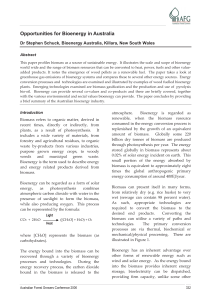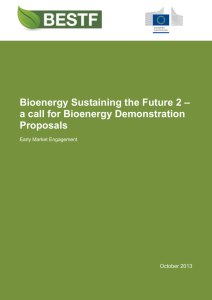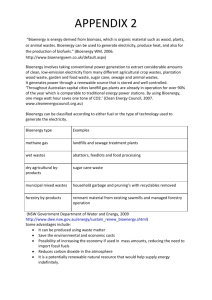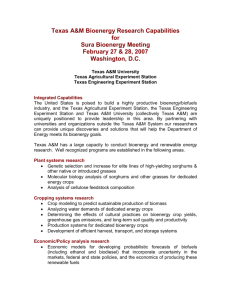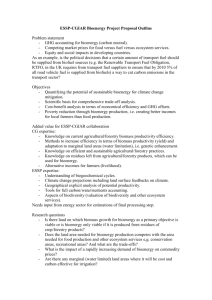The Australian bioenergy and energy from waste market
advertisement
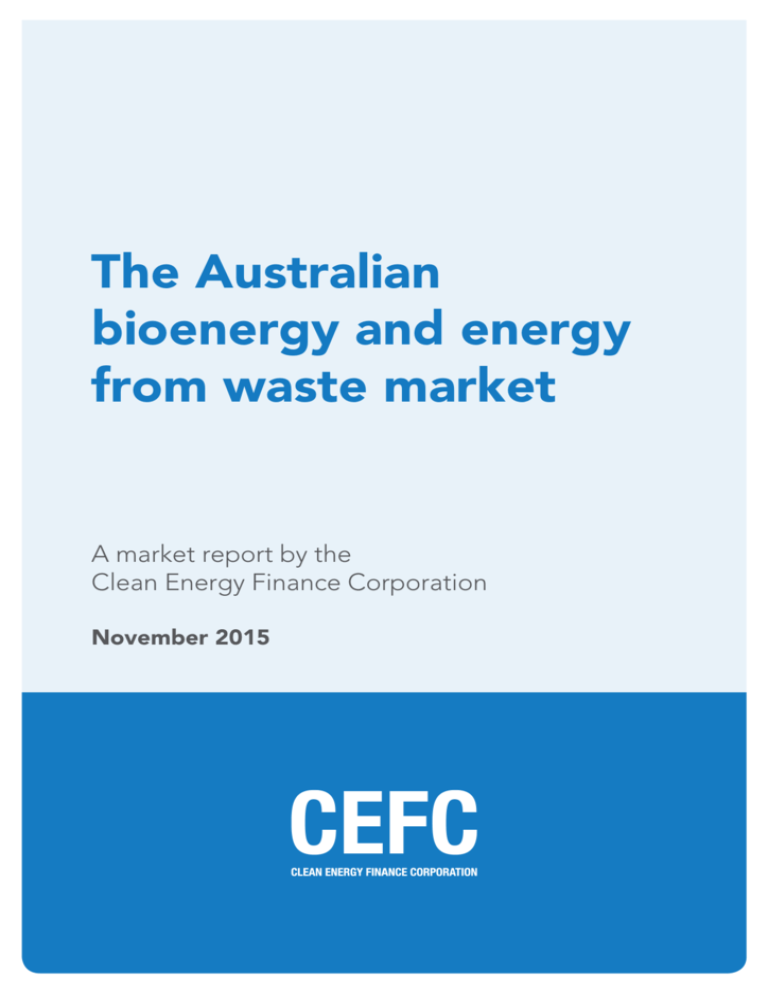
The Australian bioenergy and energy from waste market A market report by the Clean Energy Finance Corporation November 2015 About the Clean Energy Finance Corporation The Clean Energy Finance Corporation (CEFC) invests using a commercial approach to overcome market barriers and mobilise investment in renewable energy, energy efficiency and low emissions technologies. Since its inception, the CEFC has committed over $1.4 billion in finance to investments in clean energy projects valued at over $3.5 billion. The CEFC invests for a positive financial return, with more than 55 direct investments and 34 projects cofinanced under aggregation programs. These projects help to improve energy productivity for businesses across Australia, develop local industries and generate new employment opportunities. The CEFC operates under the Clean Energy Finance Corporation Act 2012. Acknowledgements The CEFC thanks Mike Ritchie and Julien Gastaldi from MRA Consulting Group and Associate Professor Bernadette McCabe from the University of Southern Queensland for reviewing this report. The reviewers bear no responsibility for any remaining errors. Disclaimer The information in this document is provided for general guidance only. It is not legal advice, and should not be used as a substitute for consultation with professional legal or other advisors. No warranty is given to the correctness of the information contained in this document, or its suitability for use by you. To the fullest extent permitted by law, no liability is accepted by the Clean Energy Finance Corporation for any statement or opinion, or for an error or omission or for any loss or damage suffered as a result of reliance on or use by any person of any material in the document. © Clean Energy Finance Corporation 2015 CREATIVE COMMONS LICENCE With the exception of the Clean Energy Finance Corporation’s logo, any material protected by a trade mark, third party copyright material and where otherwise noted, all material presented in this document is provided under a Creative Commons Attribution 3.0 Australia licence. The details of the relevant licence conditions are available on the Creative Commons website as is the full legal code for the CC BY 3 AU licence. Clean Energy Finance Corporation | The Australian bioenergy and energy from waste market | November 2015 | 2 Summary The Australian bioenergy and energy from waste market is under developed but has considerable potential. Bioenergy and energy from waste technologies have a long track record of cost-effectively reducing carbon emissions, improving energy productivity and generating reliable baseload renewable energy around the world. But these technologies are not widely deployed in Australia, contributing only 0.9 per cent of Australia’s electricity output, well below the OECD average of 2.4 per cent. This suggests significant potential for new investment. We estimate that the Australian bioenergy and energy from waste investment opportunity to 2020 is between $3.5 billion and $5 billion, potentially doubling the current level of installed capacity. We identify three areas for focus There are significant opportunities for investment in bioenergy and energy from waste in Australia, including: • in the urban waste industry, driven by a combination of rising landfill gate fees and falling technology costs • in the intensive livestock and food processing industries, driven by readily available feedstock from process waste, higher electricity prices and demand for on-site electricity, heat or steam • in energy from plantation forest residues, particularly for export as wood pellets, given low-cost and readilyavailable feedstock. BIOENERGY IS COST-COMPETITIVE WITH OTHER ENERGY SOURCES Bioenergy and energy from waste electricity generation technologies are cost-competitive where feedstock is available at low cost or as a revenue source, at larger scales and where cogeneration of heat offers opportunities to reduce other costs. As well as delivering baseload renewable energy, co-benefits from bioenergy and energy from waste include lower waste disposal costs and reduced pollution from particulate emissions, sulphur dioxide and nitrogen oxides compared with fossil fuel generation. Clean Energy Finance Corporation | The Australian bioenergy and energy from waste market | November 2015 | 3 Bioenergy and energy from waste in Australia today Traditional bioenergy and energy from waste technologies have a long track record of cost-effectively reducing carbon emissions and generating reliable baseload renewable energy in Australia. The sugar industry has generated electricity and heat from sugarcane waste in North Queensland for more than 100 years. Bioenergy share of electricity generation 0.9% Australia 2.4% OECD Source: Australian Energy Resource Assessment 2014 Despite their long history here, bioenergy and energy from waste technologies are not widely deployed in Australia, contributing only 0.9 per cent of Australia’s electricity output, compared with the OECD average of 2.4 per cent. According to Bloomberg New Energy Finance data, there are 114 bioenergy and energy from waste plants currently operating in Australia, with a total of 812 MW of installed capacity. Most established plants have less than 10 MW capacity. Bioenergy installed capacity 124 MW Forest residues 209 MW Landfill gas and sewage 480 MW Bagasse and other agricultural residues Source: Bloomberg New Energy Finance, CEFC Note: Does not sum to 812 MW due to rounding Nearly 60 per cent of installed bioenergy electricity generation capacity in Australia uses bagasse – the fibrous residue of processed sugarcane – as a feedstock. Some bioenergy generation comes from wood waste, and co-firing biomass with coal and generating electricity from agricultural waste also make a contribution. Around a quarter of installed bioenergy capacity involves using biogas from landfill and wastewater treatment for generating electricity and heat. Some farms and food processing plants use animal waste as a feedstock for heat and power. A small amount of liquid biofuel – primarily first-generation ethanol and biodiesel – is used in the transport sector. Figure 1: Most bioenergy and energy from waste facilities have less than 10MW capacity MW 80 60 Agricultural residues Forestry residues Landfill gas and sewage 40 20 0 Facilities ranked by size Commissioned bioenergy and energy from waste plants in Australia by feedstock Source: Bloomberg New Energy Finance, CEFC Clean Energy Finance Corporation | The Australian bioenergy and energy from waste market | November 2015 | 4 The largest single bioenergy facility in Australia is a 68 MW co-generation facility at the Pioneer sugar mill in North Queensland. But most bioenergy and energy from waste facilities in Australia commissioned to date are small, with plants generally having generation capacity of less than 10MW. Installed bioenergy and energy from waste generation capacity has grown slowly in Australia, increasing by an average of just 4 per cent each year over the past decade, compared with average annual growth of 65 per cent in residential solar PV capacity. Figure 2: Installed Australian bioenergy capacity has grown slowly MW Bioenergy and energy from waste Residential solar PV 2005 2011 4000 3000 2000 1000 0 2002 2008 2014 Cumulative installed capacity Source: Bloomberg New Energy Finance, CEFC Clean Energy Finance Corporation | The Australian bioenergy and energy from waste market | November 2015 | 5 The investment outlook for bioenergy and energy from waste Given the low penetration of bioenergy and energy from waste technology in Australia to date, the CEFC sees considerable opportunities to increase investment. Bloomberg New Energy Finance reports that 312 MW of bioenergy and energy from waste projects have been announced or permitted across the country. Projects that have been publicly announced include urban energy from waste projects, biomass projects using plantation forest residue feedstock, and landfill gas projects. Based on estimates from the Clean Energy Council and other sources, we estimate a potential investment opportunity of between $3.5 billion and $5 billion between now and 2020 in energy from urban waste, agricultural waste and forest residues. BIOENERGY IS COST-COMPETITIVE The economics of generating electricity and heat from bioenergy and waste resources depends primarily on choices about feedstock and technology, as well as project scale. Electricity generation from biomass is already cost-competitive where feedstock is available at low cost or as a revenue source, at larger scales and where cogeneration of heat offers opportunities to reduce other costs. Comparing new build costs, generation from landfill gas – a technology that makes up 16 per cent of installed bioenergy capacity in Australia – has one of the lowest costs of all energy sources. (See a comparison of capital costs in Figure 4 and levelised cost of energy in Figure 5.) Figure 4: Bioenergy capital costs are comparable with other technologies Figure 3: The investment opportunity to 2020 $3.5-$5.0 billion for around 800 MW of new generation capacity including $2.2-$3.3 billion for energy from urban waste $0.7-$1.1 billion for energy from food processing and animal waste and $450-$650 million for energy for AUD/KW 6,000 5,000 4,000 3,000 2,000 1,000 0 Coal without CCS Solar PV Biomass Source: Department of Industry and Science Australian Energy Technology Assessment 2013 export from plantation forest residues potentially avoiding more than 9 million tonnes of CO2e emissions each year Source: CEFC Clean Energy Finance Corporation | The Australian bioenergy and energy from waste market | November 2015 | 6 INVESTMENT DRIVERS VARY BY SUB-SECTOR BIOENERGY OFFERS SIGNIFICANT CARBON ABATEMENT OPPORTUNITIES The investment drivers of bioenergy and energy from waste vary between subsectors. For example: Bioenergy and energy from waste can reduce carbon emissions in two ways: • in the urban waste industry, a combination of rising landfill gate fees and falling technology costs make diverting waste for energy generation economic • in the intensive livestock and food processing industries, readily available feedstock from process waste, higher electricity prices and demand for on-site electricity, heat or steam make anaerobic digesters a viable investment • in the plantation forest industry, biomass-to-energy project economics are affected by feedstock production and transport costs, plant growth rates and project scale. • by offsetting emissions-intensive grid electricity, which typically is associated with emissions of ~0.9 t CO2-e/MWh • by avoiding direct methane emissions (with a global warming potential 25x that of carbon dioxide) from decomposing biomass. The CEFC estimates that new bioenergy and energy from waste projects could avoid 9 million tonnes of CO2-e each year by 2020, potentially contributing 12 per cent of Australia’s national carbon abatement task to 2020. Figure 5: Bioenergy is cost-competitive with other energy sources for new build plants AUD/MWh 300 250 200 150 100 50 Biomass Open-cycle gas turbine Coal Large-scale PV Wind Combinedcycle gas turbine Landfill gas 0 Levelised cost of energy, Australia 2015 Source: Bloomberg New Energy Finance Clean Energy Finance Corporation | The Australian bioenergy and energy from waste market | November 2015 | 7 BIOENERGY HAS SIGNIFICANT CO-BENEFITS As well as reducing reliance on fossil fuels and lowering carbon emissions, bioenergy and energy from waste have other cobenefits: • depending on the feedstock supply, bioenergy and energy from waste can provide baseload renewable electricity at high levels of availability, potentially offsetting intermittent generation from other renewable energy sources • bioenergy applications that replace alternative waste disposal methods can reduce local environmental impacts and disposal costs and the use of limited landfill space Best-practice local emissions management: The ISSÉANE energy from waste plant in Paris All new energy-from-waste incineration plants in OECD countries must meet strict emissions standards, including controls on nitrogen oxides, sulphur dioxides, heavy metals and dioxins. A large underground 52MW energy from waste plant operates in Paris on the banks of the Seine, treating 460,000 tonnes of waste each year and generating electricity and district heating for buildings including the Musée d’Orsay. The plant’s combustion gases are treated to recover 99 per cent of particulate emissions. • bioenergy plants that displace fossil fuel generation can reduce pollution from particulate emissions, sulphur dioxide and nitrogen oxides. While biomass energy projects can generate local air pollutants, emissions can be managed through best-practice treatment. Clean Energy Finance Corporation | The Australian bioenergy and energy from waste market | November 2015 | 8 Bioenergy and energy from waste: key opportunities This section discusses opportunities in urban waste, agricultural waste and plantation forest residues. ENERGY FROM URBAN WASTE Of the nearly 50 million tonnes of urban waste generated in Australia each year, more than half is recycled and around 20 million tonnes ends up in landfill. Only around 1 million tonnes is diverted for energy or advanced waste treatment (source: MRA Consulting Group). A range of different urban waste streams offer the potential for generating electricity and heat: food and garden organics, waste wood and timber, wastewater and residual waste are all potential feedstocks for energy from waste projects. The CEFC estimates a potential investment opportunity in urban energy from waste of between $2.2 billion and $3.3 billion. Local, state and national government waste policies vary across Australia, though most states have a legislated waste hierarchy designed to promote re-use, resource recovery and recycling over energy from waste. The cost of landfill is estimated at around $120/t once post-closure remediation and replacement costs are taken into account (source: MRA Consulting Group). Gate levies and other taxes to recover landfill costs are an important driver of energy from waste projects. The CEFC has investments in several urban waste projects including with landfill gas project developer Landfill Gas Industries and waste-to-gas developer New Energy Corporation. The urban waste hierarchy Prevent to avoid generating waste Reduce to conserve resources Recover and reuse materials Recycle and reprocess Energy from waste to recover energy Disposal of residual waste into landfill Source: MRA Consulting Group, CEFC Urban waste technology options Established technologies Direct combustion New and emerging technologies Thermal Gasification Pyrolysis Plasma gasification Thermal depolymerisation Non-thermal Anaerobic digestion Fermentation Mechanical biological treatment with anaerobic digestion Physical resource recovery Source: CEFC Clean Energy Finance Corporation | The Australian bioenergy and energy from waste market | November 2015 | 9 Figure 6: A significant share of most waste categories ends up in landfill kt 16,000 Energy recovery 14,000 Recycling 12,000 Landfill disposal 10,000 8,000 6,000 4,000 2,000 Glass Metals Other Paper & cardboard Plastics Hazardous Masonry materials Organics Fly ash - Waste management by material in Australia, 2010-11 Source: Department of Environment National Waste Reporting 2013 Figure 7: Landfill levies vary significantly $/t 120 100 80 60 40 20 0 2004 2005 NSW 2006 2007 Vic 2008 2009 2010 SA 2011 2012 WA 2013 2014 2015 Qld Source: MRA Consulting Group Clean Energy Finance Corporation | The Australian bioenergy and energy from waste market | November 2015 | 10 CEFC experience in bioenergy CEFC case study: Landfill Gas Industries Queensland-based Landfill Gas Industries is expanding its energy from waste operations with finance from the Clean Energy Finance Corporation. Up to $10 million in CEFC finance will facilitate LGI’s installation of 6 MW of electricity generation using biogas-fired generators at six landfill sites in Southern and Central Queensland. LGI builds, owns, operates and maintains biogas-fired generation systems at landfill sites. It sells the electricity generated into the grid. CEFC finance is secured against the projects’ revenue streams, which include payments for Australian carbon credit units under the Australian Government’s Emissions Reduction Fund (ERF). This investment demonstrates the CEFC’s capacity to accelerate projects that abate carbon and are eligible for funding through the ERF. CEFC case study: New Energy Corporation The CEFC is providing $50 million in senior debt finance to assist in developing Western Australia’s first municipal wasteto-gas project. New Energy partners with industry and local government to recover energy from waste streams that would otherwise go to landfill. New Energy uses ENTECH™ technology - a world-leading, Australian innovation that has been widely deployed and commercially proven overseas. Its proposed plant in the Pilbara will harness waste from the Port Hedland and East Pilbara councils. The plant is expected to have a capacity of 16.6 MW and has the potential to avoid around 135,000 tonnes of carbon emissions per year. CEFC case study: Richgro Major Australian garden products supplier Richgro is harnessing ground-breaking energy from waste technology to meet all its power needs by recycling organic waste. A $3.3 million anaerobic digestion plant with a capacity of up to 2 MW is being built to power equipment and the onsite vehicle fleet at Richgro's operations at Jandakot in Western Australia. The plant has the capacity to process more than 35,000 tonnes a year of commercial and industrial organic waste, diverting it from landfill. Over its 20-year life the project is expected to save 142,722 tonnes of CO2e. CEFC case study: Energy Developments Limited The CEFC provided a $75 million senior secured corporate loan to Energy Developments Limited (EDL) for investments in new projects including landfill gas. The CEFC finance has subsequently been repaid following EDL’s acquisition by the DUET Group, providing a positive market validation of the EDL business model. EDL’s landfill gas project at Brooklyn, west of Melbourne, turns gas from the landfill into grid electricity, resulting in annual greenhouse gas emissions savings of 90,000 tonnes, equivalent to taking 25,000 cars off the road. The plant uses waste methane gas extracted from the landfill. The plant operates predominantly as a baseload source of electricity. The plant is a renewable generator under the Renewable Energy Act and is eligible to produce Large-Scale Generation Certificates. Clean Energy Finance Corporation | The Australian bioenergy and energy from waste market | November 2015 | 11 CEFC case study: Bindaree Beef The CEFC is co-financing a major on-site energy project at Bindaree Beef Limited, one of Australia’s largest meat processors. Bindaree Beef will install a biodigester to produce biogas and an electricity generation facility using biogas as fuel. A new more energy efficient rendering plant will replace the existing coal-fired plant and eliminate the use of coal. The new equipment will halve power bills and reduce the impact of price increases for externally sourced water because it recycles existing waste water. This waste water and gas produced from the effluent will be used for steam generation and the creation of hot water for sterilisation purposes. CEFC case study: Darling Downs Fresh Eggs Darling Downs Fresh Eggs is using chicken manure and other organic waste from its egg production business to generate power and save more than $250,000 a year. An anaerobic digester and power plant will help Darling Downs Fresh Eggs to reduce its grid electricity usage by 60 per cent in the first year and provide 100 per cent of the company's energy in non-peak periods. Heat from the biogas generator will be captured and used to warm chicken rearing sheds and heat the water for the grading floor. ENERGY FROM AGRICULTURAL WASTE AND FOOD PROCESSING The Australian agriculture sector has produced electricity and heat from waste biomass for more than 100 years. Today, the sugar industry has 480 MW of installed capacity generating electricity from postprocessing sugarcane residue. Organic waste from poultry farms, cattle feedlots, piggeries, dairy farms and abattoirs is a biomass resource that is well suited to anaerobic digestion. In the past decade, organic waste at large livestock production and food processing facilities has been increasingly treated using anaerobic digestion to generate biogas for on-site heat and power generation. But opportunities in small and medium plants in rural and regional areas are yet to be taken up. Readily available feedstock from animal waste, higher electricity prices and demand for on-site electricity, heat or steam make anaerobic digesters a viable investment. Generating electricity and heat from agricultural waste can encourage investment in rural and regional industries, reduce on-farm electricity, waste and gas costs, diversify farming income and reduce electricity infrastructure costs. Technology options for energy from agricultural waste Established technologies Direct combustion New and emerging technologies Anaerobic digestion Covered anaerobic lagoons Heated agitated lagoons In-vessel digesters Thermal Gasification Pyrolysis Source: CEFC Clean Energy Finance Corporation | The Australian bioenergy and energy from waste market | November 2015 | 12 ENERGY FROM PLANTATION FOREST RESIDUES Forest biomass is a significant renewable energy source in many countries but is not used widely in Australia. Apart from biomass co-fired in coal-fired power plants on a small or pilot scale, there is relatively little plantation forest residue used for energy in Australia. By comparison, forest biomass contributes around two-thirds of renewable energy in Europe, mostly used for generating heat. Policy drivers overseas have created export opportunities for Australian biomass pellet producers. Brisbane-based Altus Renewables operates a plant at the Hyne sawmill near Maryborough that compresses sawdust and wood shavings into pellets for export to South Korea and Japan. United States pellet manufacturers exported more than 4 million tonnes of wood pellets in 2014, mostly to the United Kingdom (source: US Energy Information Administration). Australia’s hardwood plantation forests cover around 1 million hectares. The use of appropriate biomass from sustainably managed plantation forests can offset grid electricity use, reduce carbon emissions and promote economic development in regional areas. Plantation forests residues such as stem tops and branches left after harvest, as well as plantation forest sawmill residue and pulplog, are a potentially material source of biomass for electricity and fuel in Australia. Technology options for energy from plantation forest residue Established technologies Direct combustion New and emerging technologies Pelletisation Source: CEFC Leading opportunities include: • generating electricity from plantation forest residues using direct combustion technology to offset grid electricity consumption • producing biomass pellets for co-firing in coal-fired power plants • exporting biomass pellets for co-firing in power plants, particularly to countries in the Asia-Pacific region such as South Korea and Japan which have policies to promote biomass as a renewable energy feedstock. LONGER-TERM: THE TECHNOLOGY FRONTIER IN LIQUID BIOFUELS While we have not scoped the liquid biofuels market in this paper, world liquid fuel demand is projected to increase 38 per cent by 2040 (source: US Energy Information Administration), particularly in developing countries. Australia’s strong expertise in agricultural science and its climate suitable for growing energy crops suggest abundant capacity to help meet global demand for renewable liquid biofuels. The Australian Renewable Energy Agency (ARENA), which supports renewable energy technologies from research in the laboratory to large-scale technology projects, currently funds 15 bioenergy projects with a total project value of $70 million. 82 per cent of its current bioenergy funding is directed towards advanced biofuels projects. Clean Energy Finance Corporation | The Australian bioenergy and energy from waste market | November 2015 | 13 Who invests in bioenergy and energy from waste? Investment opportunities in the bioenergy and energy from waste sectors vary in scale and are geographically diffuse. Projects range from small-scale on-farm anaerobic digesters to large biomass-fired power plants. A range of institutions have invested in bioenergy and energy from waste projects around the world. Fund managers: The United Kingdom’s Green Investment Bank awarded a funds management mandate for energy from waste projects to investment managers Foresight Group and Greensphere Capital. Foresight Group also invests funds in energy from waste projects for the European Union’s European Investment Bank. In October this year, a consortium of fund managers including Foresight Group launched a £230 million platform called the Bioenergy Infrastructure Group to construct biomass and energy from waste plants in the United Kingdom. Pension funds: In a recent large transactions in Europe, a group of Danish pension funds invested €215m in a biomass-fired power plant project in the north of England. Corporate direct investments: In the United States, Proctor & Gamble has recently invested US$200m in a 50 MW biomass plant to provide steam and electricity for its manufacturing plant in Albany, Georgia. Drax Group, a UK electricity generator, has invested US$375m in biomass pellet production and transport facilities in the United States. In other cases, privately held companies, family offices and high net worth individuals are considering direct investments in the bioenergy and energy from waste industries. WHERE ARE THE OPPORTUNITIES LOCATED? The investment opportunities in the bioenergy and energy from waste sectors are geographically diffuse. Bioenergy and energy from waste projects depend on the supply of feedstock. Many opportunities from animal waste are in regional Australia, though urban waste opportunities tend to be near population centres. The bioenergy and energy from waste sector is diverse, with sub-sectors specialising in particular technologies and feedstocks. Projects vary in scale from small on-farm anaerobic digesters to large gridconnected biomass-fired power plants. States are at different stages of policy development. Only New South Wales and Victoria have formal energy from waste policies, though other states have policies under development and Western Australia has approved a number of large energy from waste projects. Bioenergy Australia is in the process of mapping biogas plants around Australia, while ARENA’s Australian Renewable Energy Mapping Infrastructure (AREMI) has data on landfill gas sites connected to the National Electricity Market. THE CEFC HAS INVESTED IN WASTE AND BIOENERGY PROJECTS The CEFC has already committed around $150 million in bioenergy and energy from waste projects alongside $280 million of private sector investment. Investments to date include projects for energy from animal waste, landfill gas and municipal solid waste. The CEFC’s pipeline includes $3.5 billion of bioenergy and energy from waste projects, including projects to produce wood pellets, to convert sugarcane to ethanol, to build a biofuels plant, and to convert municipal solid waste and animal waste to energy. Clean Energy Finance Corporation | The Australian bioenergy and energy from waste market | November 2015 | 14 Contact the Clean Energy Finance Corporation CLEAN ENERGY FINANCE CORPORATION Suite 1702, 1 Bligh Street, Sydney NSW 2000 TELEPHONE 1300 00 2332 1300 00 CEFC www.cleanenergyfinancecorp.com.au contact@cleanenergyfinancecorp.com.au
